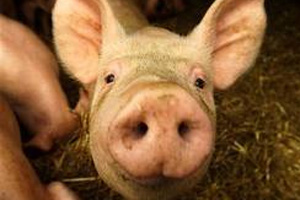Better welfare for Danish pigs – naturally

The Ministry of Food, Agriculture and Fisheries has in March 2014 entered into an agreement with the agricultural industry and other stakeholders on improving pig welfare.
DCA research supports the historic, new agreement on several fronts.
Pigs produced on Danish farms and in Danish fields must have a good life. “Naturally” most people would probably say, but it can nevertheless be a struggle for a pig to manoeuvre its way safely and soundly through life from birth to slaughter. Depending on the type of production (conventional and organic), about 22-33 percent of piglets will die within a few days of birth. Most of the surviving piglets will have half of their tails docked, male pigs will be castrated and older animals risk getting ulcers.
The producer is constantly seeking to reconcile optimal welfare with optimal production, efficiency and working conditions, but it can be a difficult balancing act in practice since there are many factors to consider.
Mortality, tail-docking, castration and ulcers are undesirable companions in pig production, but they can be minimised or even eliminated through targeted research. By combining research with practical experience in a close partnership between industry and research institutions, progress has already been made.
Research improves welfare
In spring 2014 the Ministry of Food, Agriculture and Fisheries, the agricultural industry and other stakeholders signed an agreement on improving pig welfare. In several of the areas covered by the new agreement and listed below, scientists from Aarhus University and DCA will be able to contribute with existing or future research:
• Higher survival rates of piglets
• Fewer lactating sows to be restrained
• Fewer pigs to be tail-docked
• Fewer ulcers in pigs and sows
• No male pigs to be castrated without anaesthesia
• Animal welfare to be incorporated into the “First pig on the moon” project
Piglet mortality has several causes. This means that there are several levers that can be tweaked in order to reduce it. One of the scientists working extensively with various aspects of pig welfare is senior researcher Lene Juul Pedersen from the Department of Animal Science. She has several ideas on how piglet mortality can be reduced.
“An obvious way ahead is to attach more importance to piglet survival in the breeding index. Today what you breed for is number of surviving pigs on day 5, and this has increased the number of weaned pigs significantly since the breeding programme was introduced, while the proportion of dead pigs has been considerably reduced,” says Lene Juul Pedersen and continues:
“Increased monitoring of the farrowing has the potential here and now to reduce both the proportion of stillborn piglets and the proportion of piglets that die shortly thereafter. Similarly, improvements in the pigs’ thermal environment at birth could reduce mortality. Measures such as straw and extra heating sources located in the right places in the farrowing pen could be a solution.”
In addition to researching the importance of straw in the design of the farrowing pen and the piglets’ immediate surroundings, Lene Juul Pedersen has also studied the role of straw in satisfying the manipulative requirements of pigs. In modern housing systems large quantities of straw must be applied to fully meet the requirements of the pigs, but since the pigs will respond with a higher growth rate, lower incidence of ulcers and less tail-biting, it would probably make good business sense to change the housing to better accommodate straw. In addition, increased dry matter in the manure may have the potential to reduce emissions of ammonia, greenhouse gases and odour, and increase the biogas potential.
Tail-biting is a problem that can be more painful for the pig than getting the tail docked, but if both tail-docking and tail-biting can be avoided, it would be the best solution for both the pig and the farmer. Scientists in the Department of Animal Science are involved in both Danish and international research projects on this issue. The research is supported by funds from, respectively, the Ministry of Food, Agriculture and Fisheries and the EU.
When it comes to finding out how the castration of male pigs can be avoided, scientists from Aarhus University are also involved. The knowledge on pig welfare that scientists from the Department of Animal Science generate could form a natural part of the “First pig on the moon” project of the Danish AgriFish Agency. The project aims to reconcile environmental concerns, animal welfare and a larger pig production through innovative solutions. Aarhus University is one of the partners in this major project.
Further information: Senior researcher Lene Juul Pedersen, Department of Animal Science, email: Lene.JuulPedersen@agrsci.dk, telephone: +45 8715 7907
Source: Janne Hansen, Aarhus University











